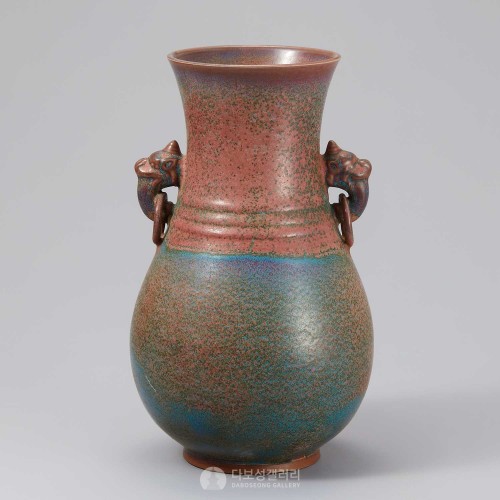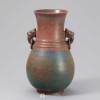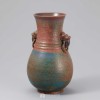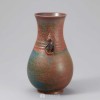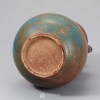본문
구연부와 굽이 넓고 몸통이 둥글며 목의 양쪽에 상상의 동물인 포수(鋪首)가 둥근 고리와 함께 붙어 있는 북송 균요 포수쌍이병(鋪首双耳甁)이다.
손잡이를 기준으로 윗부분은 붉은색을 띠며 아랫부분은 푸른색을 띠는데, 붉은색 사이사이에 푸른색이 희끗희끗 보이면서 어우러져 있어 색상의 조화가 매우 오묘하고 아름답다. 이렇듯 하나의 도자에서 신비스러운 여러 색채 변화를 보이는 것은 균요(均窯) 자기의 특징이다. 균요는 두 차례의 소성으로 만들어지며 두 번째 소성시 유약을 시유한다. 소성 시 홍·남·청·백·자색 등이 서로 유화되어 반점이 생기거나 원래 색상과 달라지기도 하는데 이를 '요변(窯變)'이라고 한다.
该北宋钧窑铺首双耳瓶口沿部和底部较宽,瓶体呈圆形,颈部两侧对称饰圆形的想象动物的铺首。
以手柄为基准,上部呈红色,下部呈蓝色,红色之间蓝白相间,颜色协调非常奥妙美丽。像这样,在单一陶器中呈现神秘色彩变化的技术是钧窑的特色。钧窑要经过两次烧制,第二次烧制后进行施釉。烧制时红、蓝、青、白、紫色等相互乳化生成斑点或与原来的颜色不同,称为“窑变”。
The vase, made in the Jun Kiln in the Northern Song Dynasty, has a round belly rising from a wide foot to a drooping shoulder, a neck flanked by mythical-beast handles suspending rings, and a wide mouth.
Above the handles is tinged with red, and beneath is blue. Red splashes subtly coordinate with blue blur under. Such mysterious color variation in a single ceramic is the specialty of Jun ware. Jun ware is fired twice and glazed after the second firing. When the firing, red, blue, white, purple, etc. emulsify each other to form spots or get different from the original color, which is called "yaobian."
